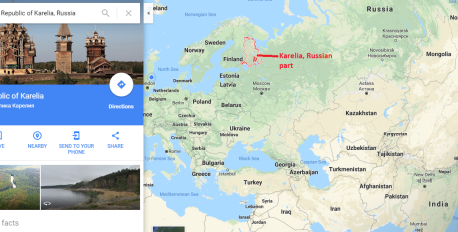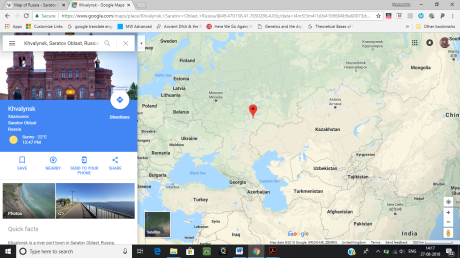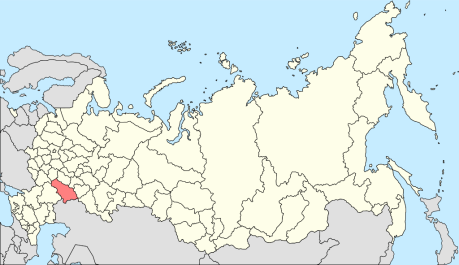La Genetique Scandale
A critique of the recent articles particularly one by Narasimhan
(This will be in 4 parts)
By Premendra Priyadarshi
PART 1
Cracking the Narasimhan Code
The article by Narasimhan et al (BioRxiv)uses a large number of words, abbreviations and location names, most of which have been created arbitrarily and may be misleading to the reader. I believe, it was done by them inadvertently, not intentionally. To understand the impugned article as you go into it you need to understand these words/names first. I have explained them below. Where necessary, I have pointed out the flaw in the hypothesis/inclusion of the name.
1. Karelian: The word Karelian is central to the article. The ultimate goal of the somersaults in the article is to prove by hook or by crook that the Baltic region (Karelia) was the home of the Proto-Indo-Europeans. Karelia is a region now divided into two parts—one in Finland and the other in Russia. Its language is not Indo-European, but Finnish, which belongs to the Finno-Ugric Language family. The Eurocentric Aryanists have long been claiming that the Finnish (and its sister Hungarian) have come to their present locations from Siberia.

Karelia
Source: Google Map.
While the rest of the region of Europe to the south of Karelia was having Mesolithic and later agricultural revolution, and the mode of subsistence was changing to farming and pastoralism, the region surrounding Karelia was still having hunter-gatherer-fisher existence until quite late.
Hence when the word Karelian Hunter Gatherer is used it should be considered to be belonging to a much later period, later by several thousand years, as compared to the Neolithic periods of India, Anatolia and Iran. In fact when it was Neolithic in India and Anatolia, it was Mesolithic in Europe in general and Hunter-Gatherer (Upper Palaeolithic) in the northern Europe.
Two ancient human DNAs have been retrieved from Karelia for this study. One dated 6425 BC (Y-DNA hg R1a-M420); and the other 5250 BC (Y-DNA hg J). The R1a-M420 is today common in Iran, Caucasus and Eastern Arabian Peninsula. Narasimhan claim that Karelian DNAs have more of Ancestral North Eurasian (ANE) ancestry than any other ancient or modern population. As evidence to this they allege that it is close to the sample from Afontova Gora (ca. 15980 BC), located to the west of Lake Baikal.
The resemblence of Karelian to Western Lake Baikal HG DNA only means that the c. 16,000 BC Lake Baikal, c. 6500 BC Karelia and c. 5250 BC Karelia individuals had been derived from some common ancestral population located to the southern latitudes of Asia. This could have been somewhere between the Pamir and South Caspian bank or the region located somewhat north of this line.
This assumption is necessitated by the fact that Karelia (and also West Bank Baikal) suffered two episodes of depopulation between 16,000 BC and 5250 BC. This we know from geological studies. One was at the Tardiglacial about 11,500 BC and the other was about 6200 BC (8.2 Kilo-climatic-event). In fact, the Baikal 16000 BC human sample was also the result of a migration from the south, initiated in response to the de-glaciation event which started at 18,000 BC. These DNAs must have prevailed in India and Iran too during those days. However the sporadic and focal bursts of the Neolithic promoted some newer lineages leading to the extinction of most of the Indian lineages of Upper Palaeolithic India. The same fact is true for Anatolia and much of Iran too.
The 6500 BC Karelia sample could have been due to the migration initiated from West Asia and Mehrgarh in response to the Neolithic revolution and consequent population explosion in Europe and Asia. At this time we get Mesolithic culture in Southern and Central Europe. Its R1a-M420 Y-DNA indicates the source from Asia. The 5250 BC Karelian sample was from West Asia through Caucasus and North Pontic regions; secondary to the adoption of Neolithic in that region about 5500-5000 BC. This we can say from the Y-DNA J, and also from the study of the ancient DNAs of Neolithic Iran, Caucasus and steppe.
The article (Narasimhan et al) uses the words EHG and Karelian Hunter Gatherer interchangeably. The ultimate aim is the prove that Karelia was the source of the MLBD_steppe’s Indo-European speaking component.
2. EHG : EHG has been explained by Narasimhan as Eastern European Hunter-Gatherers. The Main Article explains this component of Eurasian ancestry as “Eastern European Hunter-Gatherers represented by hunter-Gatherers from the diverse sites in Eastern Europe”. However in the supplement to the text where actual discussions have been done, the article means, implies and uses only the Karelian genes/DNA/Genome (and probably also Samara_HG) for this purpose. I don’t think that it (the nomenclature EHG given to Karelia_H_G) was deliberately done to mislead people. It was a product of poor naming, writing and editing skills. In fact the EHG (Eastern Hunter Gatherer) name should have been given to East Eurasian Hunter Gatherers from Japan, Korea and coastal East China.
3. Khvalynsk_EN: Khvalynsk Eneolithic (EN here meaning Bronze Age, and not the Early Neolithic). Its period is 5000-4500 BC. The PCA by the authors found that the Khvalynsk population consisted of people from Karelia of Finland:

Khvalynsk Location
Map showing Location of Khvalynsk (Google Maps)

Location of Khvalynsk in flattened map
They write, “Khvalynsk_EN can be modelled with Karelian HGs as a primary source of ancestry and about 20% Iranian agriculturalist related ancestry. This shows that the results of our modeling precedure are consistent with the observations in refs. (75) and (83), where a slightly modified qpAdm procedure and different sets of outgroups were used (Table S3.45).” [Lines 4116-4120, Narasimhan Supplement]
The plain English meaning of this quoted passage is — The Bronze Age people of Khvalynsk region, which is located to the East and north of Ukraine, came from Finland at about 5000 BC.
This interpretation by the authors is naïve because Finland and adjoining Baltic regions had very low food productivity until as late as about 2000 BC. It could not provide immigrants to a distant region like Khvalynsk at 5000 BC. Moreover the rule in Archaeology and history is that the farmers penetrate into the hunter-gatherer territories, not the vice-versa. The fact of resemblance between Karelian and Khvalynsk at this time needs to be interpreted as follows:
The Khvalynsk 5000 BC should be considered to be composed of two components. One arriving here and settling much earlier, even before 6200 BC, from a source population locate in Pre-Ganj-Dareh Iran/ Caucasus. This would be of the same stock as the Karelian samples as the Karelian too might have arrived from this region to Finland earlier. This human genetic layer formed the existing substratum of people in the region between Volga and the Baltic region, when the people with Neolithic arrived from the south at about 5000 BC. Thus Khvalynsk was retaining 80% of this gene pool between 5000 BC and 4500 BC. Further arrivals from the south would further dilute this gene component with time.
And the other (20%) component of Khvalynsk arrived to this region in a Neolithic wave from North-West Iran after 5000 BC, and this event was after the establishment of the Ganj-Dareh population in west Iran, which had taken place about 7700 BC, but fresh wave of these people reached north of Caucasus only after the 8.2 kilo-event had passed. We know from the other studies (Lazaridis 2016) that migration from Iran through Caucasus to Volga and north Pontic-Caspian region took place about 5500 to 4500 BC. We have to understand also that it is this latter Iranian population (from Ganj Dareh stock) only which has been named as Iranian Agriculturist in the article by Narasimhan.
4. Iranian Agriculturists: The authors mean the six Ganj-Dareh ancient human samples dating about 7900-7700 BC only by the term “Iranian Agriculturists”. They do not include other Iranian agriculturists in this term e.g. Wezmeh Cave Zagros Farmers (Broushaki 2016). [Quote from Broushaki: “These people are estimated to have separated from Early Neolithic farmers in Anatolia some 46-77,000 years ago and show affinities to modern day Pakistani and Afghan populations, but particularly to Iranian Zoroastrians.” Broushaki: Abstract. Clearly Broushaki is talking about the split into two of the Early Eurasians coming westward from coastal western India (Gujarat-Sind) and one moving ahead to give rise to the European and Anatolian Hunetr-Gatherers (Cro-Magnons)and the other staying back in Pakistan-Afghanistan–East Iran region. This we can understand from the received knowledge about early Eurasian migration.]

Thus in fact the expression ‘Iranian Agriculturist’ must have included Wezmeh Cave within its meaning, who had migrated to Zagros from a location within Pakistan/ Afghanistan. The Wezmeh DNA could have been named ‘Iranian Agriculturist II”. In that case it would have been all right.

Source: Broushaki 2016:Fig 4. Wezmeh is related to Indian, and Europeans are related with Barcin Anatolian.There is a break or discontinuity between Anatolian DNAs and West Iranian DNAs at this time. This indicates recent arrival from the Eastern countries to West Iran. Long-standing coexistence would later create clines between Iran and Anatolia, which was absent at the Neolithic period.
5. Anatolian Agriculturist: It is another misnomer in the article. Anatolian farmers were not one people. Originally there lived Hunter-Gatherers in Anatolia who were homogeneous with the people of Europe and Caucasus before the Holocene. But Holocene brought first the Mesolithic people from somewhere else to Anatolia. Then another wave brought Early Anatolian farmers. These were replaced by Mid- to Late- Neolithic farmers from Iran arriving in Anatolia.
6. Samara: Samara has been considered EHG (East European Hunter Gatherer. However Middle Bronze Age population had received about half of its genome from Armenia (Indo-European speakers) located to the north of west Iran. “Poltavka Middle Bronze Age (2900-2200 BCE) population that followed the Yamnaya in Samara, are all genetically homogeneous, forming a tight “Bronze Age steppe” cluster in PCA (Fig. 1b), sharing predominantly R1b Y-chromosomes5,7 (Supplementary Data Table 1), and having 48–58% ancestry from an Armenian-like Near Eastern source (Extended Data Table 2)” [Mathieson 2016:page 4] This fact has been concealed by Narasimhan, and they have projected a different source of Samara Middle to Late Bronze Age population. They think this source was Baltic region. But no evidence has been provided.
7. Late Bronze Age Steppe (MLBA_steppe): They think it was formed from arrivals from Baltic Europe and Baikal region inputs. However it has been clarified by Mathieson (2016 Nature) as this: “Further evidence that migrations originating as far west as central Europe may not have had an important impact on the Late Bronze Age steppe comes from the fact that the Srubnaya possess exclusively (n=6) R1a Y-chromosomes (Supplementary Data Table 1), and four of them (and one Poltavka male) belonged to haplogroup R1a-Z93 which is common in central/south Asians12, very rare in present-day Europeans, and absent in all ancient central Europeans studied to date.”
8. West Siberia: They have used the words West Siberian Hunter Gatherers and West Siberian Neolithic. West Siberian HG has been considered a primary component in the article. The region is not at all located in the west. Ironically it is straight to the north of Mehrgarh, in the same longitude. Its yellow colour in the PCA histogram provided by the Narasimhan makes clear that it had significant Andamanese/ Ancestral South Asian component in it. It is located just to the north of Kazakhstan boarders.
Narasimhans write: “West Siberian Hunter-Gatherer (West_Siberian_HG)-related”: a newly documented deep source of Eurasian ancestry represented here by three samples” [lines 201-2 main article]
However the PCA picture indicates that this component itself is formed of two segments, one from Onge (India) which is yellow; and the other from local older population which is green.

West Siberian Neolithic shown in top line. The green component in it is original hunter-gatherer West Siberian population which is two-thirds. However the Neolithic of the West Siberia does include the yellow (Indian) component in about one third quantity. Clearly it indicates arrival from Mehrgarh in response to population expansion caused by Neolithic in Mehrgarh at about 8000 BC, much before the Yamnaya etc were formed.
The take home summary for today is that the whole story has been created in such a way as to appear that it is the Karelia (Baltic) component which contributes to the Steppe population to make it MLBA (Indo-European Speakers). The long-term game plan of the authors will become more clear to you as you will understand bib-by-bit the whole plot of the impugned article by Narasimhan. Thus on the ultimate analysis, we can perceiceve that the Narasimhans want to prove the out-dated concept that ultimate home of the Proto-Indo-European is Karelia or the Baltic Peninsula of the North Sea. This was originally called the Lachs Theory (Lachsargument) of IE origin given by German Scholar Schrader and later adopted by Thieme. See in the link.
https://en.wikipedia.org/wiki/Salmon_problem
To be continued as Part II next week.
There are some issues with your interpretation. You are talking about 1/3rd AASI component (which it’s not but anyways) in West Siberian Hunter gatherer due to Neolithic expansion from Mehrgarh 8000 BC but based on brushaki et al you argue that the early zagros farmers probably arrived from that region(highest similarity of WC1 with Balochi ,Makrani). So,the West Siberian Hunter Gatherer should contain something like EHG and Iran Neolithic if at all people from Meghgarh migrated to North around 7000 BCE.
Of course,the work around would be the assumption that people as far as western part of subcontinent would have high % of AASI component as early as 8000 BCE and then were subsequently replaced(and partially absorbed) by the people having affinities to WC1 but that would be exactly what Narsimhan et al would be saying and it would completely go against your thesis 🙂
I need to modify a few things and explain a few more in a better way. Thanks for the comment.
There was an old paper “Hegelian logic and the Harappan Civilization: An Investigation of Harappan Biological Affinities in light of
recent archaeological and biological research” by Hemphill and Lukacs.
Based on the analysis of cranial non-metric and dental non-metric features , they proposed a “dramatic differences in the biological affinities between the inhabitants of Neolithic and Chalcolithic Mehrgarh representing a disruptive event consistent with population replacement.
By contrast,similarites between chalcolithic mehrgarh,mature phase harappans and post-Harappan Timargarha suggest continous change from early to late chalcolithic period. Affinties between Harappans and post-Harappan Timargarha with inhabitants of Tepe-Hisaar 3 suggest sustained interaction and gene flow between Indus valley and the Iranian Plateau. “